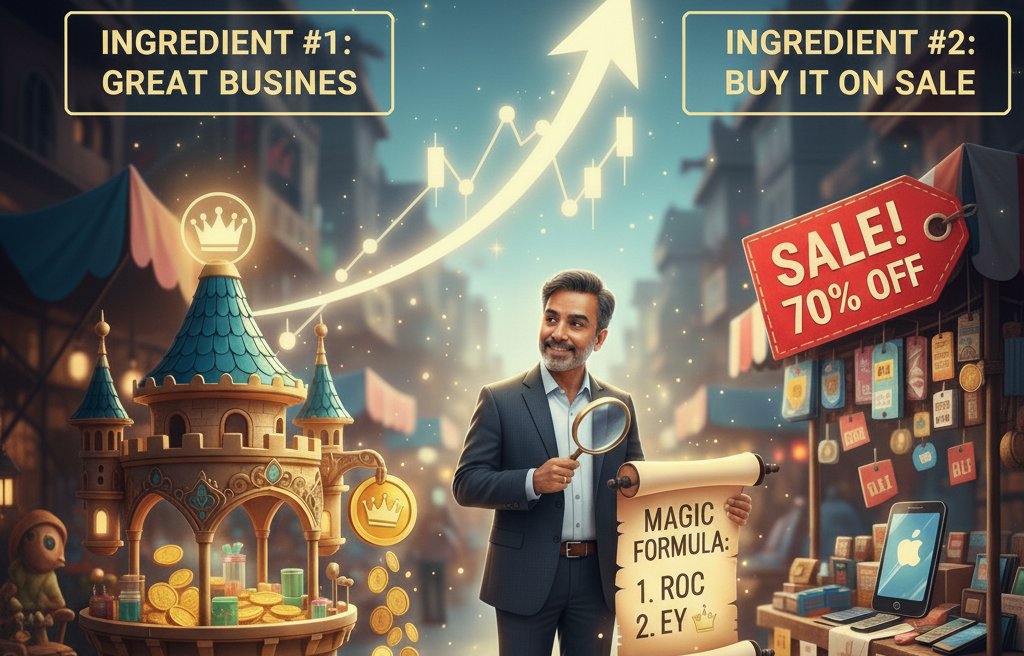Ever feel like picking winning stocks is a secret game only Wall Street pros can play? You scroll through hundreds of charts and news headlines, feeling more confused than when you started. 🤯
What if I told you a legendary investor created a simple, two-step recipe so easy anyone could use it to find great investments?
His name is Joel Greenblatt, a hedge fund manager who delivered mind-blowing returns for years. He boiled down his entire strategy into something he called the “Magic Formula.“ It’s not actually magic, but a brilliantly simple way to find amazing companies without paying a fortune for them.
Let’s break it down.
Ingredient #1: Find a Great Business 👑
First, forget the stock price. The formula focuses on finding high-quality businesses. How? By looking at something called Return on Capital (ROC).
Don’t let the name scare you. It just asks a simple question: “For every dollar this company invests in itself (building factories, new tech, etc.), how much profit does it spit back out?”
-
Imagine two lemonade stands. Stand A uses $100 in equipment to make $50 in profit. Stand B uses $500 to make $100 in profit.
-
Stand A is the better business! It’s way more efficient at turning its capital into cash.
The Magic Formula scans the market for companies like Stand A, the most profitable, efficient businesses out there.
Ingredient #2: Buy It On Sale 🏷️
Finding a great company is only half the battle. Even the best business is a bad investment if you overpay.
This is where the second ingredient, Earnings Yield (EY), comes in. This is just a fancy way of asking: “How cheap is this company’s stock compared to the profits it’s making right now?”
It’s like finding a brand-new iPhone being sold at a huge discount. It’s a high-quality item at a bargain price. The formula hunts for these “on-sale” stocks, giving you more bang for your buck.
The Million-Dollar Question: Does It Work? 🧐
So, what happens when you combine these two ideas? there are the test in the Indian stock market during one of history’s most volatile periods (2007-2010). The results are eye-opening.
Test #1: Riding the Rebound (2009 – 2010) 🚀
During the market recovery, the results were spectacular.
-
The formula’s top 20 stocks delivered an incredible 161% return for the year.
-
The overall market (the BSE-200 index) returned just 72.1%.
-
Even better? Not a single one of the 20 chosen companies lost money!
Some picks, like Ahluwalia Contracts, returned a stunning 340%.
Test #2: The Ultimate Stress Test (During the 2008 Crash) 🛡️
What about when the market is collapsing? A backtest from 2007-2008 showed the formula’s true strength.
-
The formula’s portfolio still returned an impressive 22.3%.
-
Meanwhile, the overall market lost 7%.
-
Only 3 of the 20 stocks in the portfolio lost money.
The Reality Check ✅
It’s not perfect. The next year’s portfolio (2009-10) was much weaker, with several stocks losing value. This proves Greenblatt’s point: the formula won’t win every single year.
The Catch: It Requires Patience, Not Genius ✨
Greenblatt himself warns that the formula isn’t a get-rich-quick scheme. It won’t beat the market every single month or even every year. Some years, it will fall behind.
Its success comes from sticking with the strategy over the long term (3-5 years or more), trusting the simple logic that buying good companies at fair prices is a winning strategy. It’s about discipline over drama.
What do you think? Is this a strategy you could see yourself using? Let me know in the comments!
Follow me for more simple, smart investing strategy.
Join the Relax to Rich Club, where we grow wealth the calm, thoughtful way. ✨

